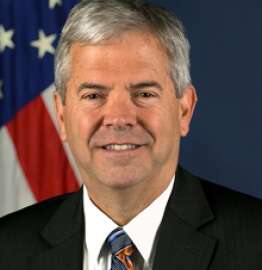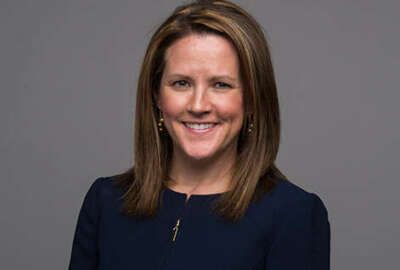
Baldwin moves from Transportation HQ to FAA for CIO role
Andre Mendes, who has been acting CIO at the Commerce Department since August, is now the permanent technology leader. Beth Angerman, the former GSA principal...
For the first time in recent memory, the Transportation Department and the Federal Aviation Administration will have chief information officers that are on the same page.
The reason for this is not because former FAA CIOs — there hasn’t been a permanent one in three years — were unwilling or unable to work with the larger DoT. The optimism comes from the fact that the FAA named Kristen Baldwin, the DoT deputy CIO, as its new CIO.
Sources told Federal News Network that Baldwin will start at the FAA on Feb. 17. She replaced Sean Torpey, who had been acting CIO since December 2016. Torpey became the FAA’s executive director of its National Engagement and Regional Administration in October. Melanie Boteler, the FAA chief information security officer, has been acting since Torpey moved to a new role.
The FAA, like other large bureaus in agencies, has not always played well or taken instruction well from their parent organization. This was especially true in 2016 when former Transportation CIO Richard McKinney brought the Federal IT Acquisition Reform Act (FITARA) hammer down around two-factor authentication for privileged users and during the 2017 budget planning process when he required components to file a spend plan with the CIO’s office.
Current CIO Ryan Cote has a plan to centralize all back-office or non-mission IT by 2021, except for the FAA. But with Baldwin on board at the administration, Cote will have an easier time aligning DoT and the FAA.
Related Stories
One of Baldwin’s biggest challenges will be around cybersecurity. The DoT inspector general wrote in the 2019 report on actions taken to address the FAA’s top management challenges that cybersecurity has consistently been an area of concern.
The FAA’s strategic plan for 2019-2022 also provides a clue for where Baldwin will have to focus. The plan calls for technology innovation by using data to improve decision making through artificial intelligence and advanced algorithms.
“By 2022, the FAA will have realized expanded capabilities to conduct its mission support services through more efficient use of human capital resources,” the plan stated. “The agency will have expanded its alignment with DoT as well as shared services and personnel reform goals. More efficient use of resources will have led the FAA to improve its use of taxpayer funds in continued support for American industry and increased economic opportunities. Internal process and automation improvements will have resulted in a more streamlined and efficient shared service environment within the FAA, and will factor in the reduction of regulatory costs to regulated parties.”
While FAA gains a CIO, the Agriculture and Homeland Security departments are losing key IT executives.
USDA, DHS lose IT officials
Chad Sheridan, USDA’s the chief of service delivery operations, is heading to the private sector.
Sheridan said it was time to try something else after 26 years in government, including the last 10 with USDA.
He will start on Feb. 18 as the chief innovation officer for an IT services and consulting company called Net Impact Strategies.
Sheridan said he’s worked on three major programs during his career ranging from the next generation air craft carrier to the development of the farmers.gov portal.
Meanwhile, Sean Hughes, the Department of Homeland Security’s director of its Enterprise Network Modernization Program/Enterprise Infrastructure Solutions (EIS) transition is leaving federal service.
Hughes confirmed that he will be the assistant vice president for application management and operations at the Navy Federal Credit Union. He joins former DHS deputy CIO Stephen Rice, who is the NFCU deputy CIO.
His last day at DHS will be Feb. 14.
Hughes’ departure leaves another in a growing number of holes in the DHS CIO’s office. Currently, the CIO, deputy CIO and soon enterprise network modernization program director will all be filled by acting.
Speaking of the private sector, Beth Angerman, the former General Services Administration principal deputy associate administrator in the Office of Governmentwide Policy since February 2018, is joining Slalom, a technology and business consulting firm, on Feb. 12. She will be a client service partner with the company.
“Slalom is excited to have her join our federal leadership team,” said Luanne Pavco, general manager Slalom in an email to Federal News Network. “Her expertise and passion for people and transformation will accelerate Slalom’s vision: bringing our core capabilities to federal clients focused on modern technology, modern culture, and modern ways of working.”
Angerman left GSA in December after almost 15 years in government.
Two other changes in the federal technology sector worth noting: Andre Mendes is now the permanent CIO at the Commerce Department, according to his LinkedIn page. He had been acting since August when Terryne Murphy left for a new position at the Railroad Retirement Board.
Finally, Justin Marsico is the new chief data officer at the Bureau of Fiscal Service at the Treasury Department. He added the CDO hat to his existing role of the deputy assistant commissioner.
Copyright © 2025 Federal News Network. All rights reserved. This website is not intended for users located within the European Economic Area.
Jason Miller is executive editor of Federal News Network and directs news coverage on the people, policy and programs of the federal government.
Follow @jmillerWFED






